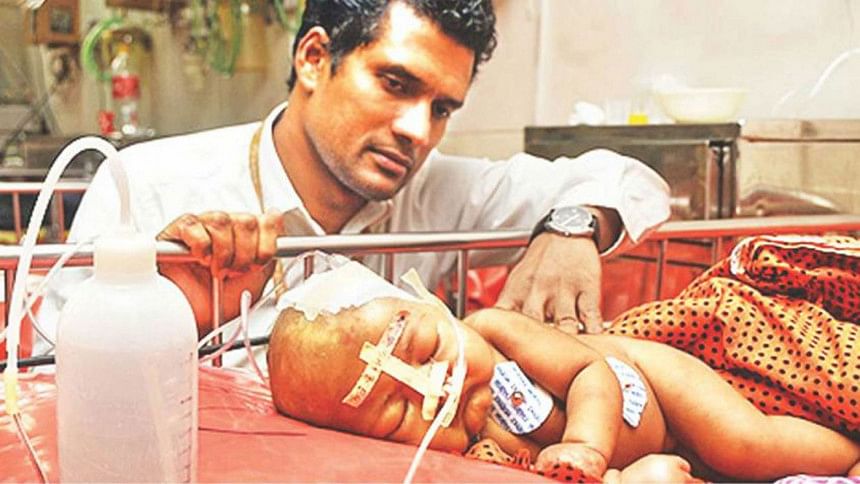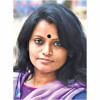Why are so many children still dying of pneumonia?

It is hard to believe that three children still die of pneumonia every hour in Bangladesh, according to a recent Prothom Alo report. Pneumonia is still one of the major causes of child deaths in the country, despite the government's vaccine coverage being more than satisfactory—the current vaccination rate for pneumonia is 97 percent.
The WHO estimates that every year around 8 lakh children die of pneumonia across the world, 90 percent of them in the African and South Asian countries. While most deaths occur among children under the age of two, around 153,000 children die within the first month of their life. Such a high number of deaths from this disease is particularly shocking because it is preventable with vaccines and treatable with low-cost medicines.
Studies have revealed that child deaths from pneumonia are not decreasing at the expected rate in Bangladesh. According to the Bangladesh Demographic and Health Survey 2017-2018, child deaths from pneumonia was 12 per 1,000 live births in 2011, and currently it is eight among 1,000 live births.
So unless we take extreme measures to reduce pneumonia-related child deaths, it would be impossible for us to bring down our overall child mortality rate. With such a high number of children dying of a preventable disease every year, achieving the SDG goal 3.2 by 2030 (bringing down the child mortality rate to as low as 2.5 percent) will also remain a distant dream for us.
Now, the question is, why are we failing to prevent these deaths despite having a good vaccination coverage against pneumonia? According to Dr Sabbir Ahmed, Advisor, Pneumonia Centenary Commitment, Save the Children in Bangladesh, "the Pneumococcal Conjugate Vaccine (PCV), which is included in the EPI programme and is widely given to our children, has a good vaccine coverage, but it only protects children from the leading bacterial cause of pneumonia-pneumococcus, while various other organisms may also cause pneumonia either singly or in combination."
So, how do we prevent other organisms from causing the disease? Samir Kumar Saha, executive director at Child Health Research Foundation, says, "We do not know whether an infection is caused by a virus or a bacterium. We need to conduct research to know it, but sadly, no research initiatives have been taken so far to understand this." (Prothom Alo, November 12, 2020)
If we still cannot tell which germ is causing the infection in children, how can they be treated? Where is the research to find out the reasons behind such high prevalence of pneumonia in our children? Our health budget being so low, research activities seem to be out of the consideration of the government. This has to change. When our children are dying from preventable diseases, we need to know why and we need to find a way to save them at all costs.
Then comes the question of treatment: why can't our hospitals provide proper treatment to pneumonia-infected children? Apparently, most of the hospitals are not even properly equipped for childcare. According to the Bangladesh Health Facility Survey 2017, 95 percent of hospitals and healthcare institutions in the country do not have all of the 10 basic instruments required to treat children, as suggested by the WHO. These include the Integrated Management of Childhood Illness (IMCI) guideline, staffers trained under the guideline, child scale, thermometer, growth chart, medicine, ORS, zinc tablets/syrup, amoxicillin syrup/suspension, and mebendazole. When hospitals do not even have these basic tools, how can we expect them to provide treatment for pneumonia?
Early diagnosis is crucial to prevent pneumonia in children. But parents, particularly in rural areas, have very little idea about the disease and so they often take their children to the hospital when it's too late. According to an icddr,b study, 52 percent of children who die of pneumonia are never taken to any hospital. While 45 percent of them die at healthcare centres, three percent die after being treated at home. What this means is, more information about preventing pneumonia should be made available to people in rural areas.
At the beginning of this pandemic, another problem faced by our hospitals and health complexes was revealed: the absence of an oxygen supply system. It was revealed at that time that not only the hospitals at the upazila level but a majority of hospitals at the district level also did not have any oxygen supply system. We learned that the government had taken some initiatives to address the issue but we do not have any updated information on this. Needless to say, all the government health facilities must have uninterrupted oxygen supply to treat both children and adults for pneumonia and other respiratory diseases.
Unfortunately, no matter how hard we try to eliminate pneumonia through vaccination and treatment, children will still be prone to catching the disease if they remain malnourished. Lack of proper nutrition is a big issue in fighting pneumonia and other deadly diseases in under-five children. Thus, besides ensuring high coverage of vaccines and timely treatment at the community level, we need to encourage exclusive breastfeeding of children for six months. Taking appropriate complimentary infant and young children feeding programmes is similarly important to fight malnutrition, thereby reducing their chances of developing pneumonia.
We also need to give more focus on maternal health. The nutritional needs of the expectant mothers should be met properly for the wellbeing of both the mother and the child. A malnourished mother cannot give birth to a heathy child. Women living in the villages and the remote areas should have access to proper antenatal care.
It must also be mentioned here that the deteriorating air quality in Bangladesh, especially in the capital, is greatly contributing to children developing pneumonia and other air-borne respiratory diseases. In the rural areas, the fumes created by traditional cooking practices in the households contribute a lot to air pollution, which affect children the most. In order to reduce air pollution in and around the capital, the illegal brick kilns on the outskirts of the city must be shut immediately, as directed by the HC. Other factors contributing to air pollution, such as construction dust, chemicals emitted from vehicles, open burning of solid waste and chemicals, etc., must also be checked. And to improve the air quality in the rural areas, people must be made aware of air pollution and have access to clean and safe fuel for cooking. With improved air quality, the onslaught of pneumonia in children will surely lessen.
A recent report by Save the Children and Johns Hopkins University highlighted the need for more collaborative efforts to fight pneumonia. It said that nearly 140,000 child deaths from pneumonia and other related diseases could be averted in Bangladesh over the next ten years with well-coordinated efforts.
Will we act now?
Naznin Tithi is a member of the editorial team at The Daily Star.

 For all latest news, follow The Daily Star's Google News channel.
For all latest news, follow The Daily Star's Google News channel. 



Comments